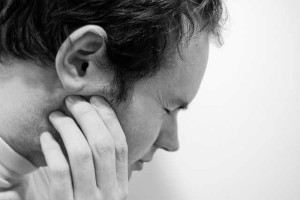The Chewing Hangover
February 16, 2016
The following is a guest blog from Sarah Fatherley, an Ehlers-Danlos and TMJ patient/activist from the United Kingdom who has appeared on panels with Dr. Mitakides, both in the U.S. and Great Britain. Please keep in mind that these are the thoughts and ideas of a patient learning to cope with daily TMJ pain, not those of Dr. Mitakides.
For years, I have loved chewing gum. I started chewing gum after meals as it seemed to help with my EDS gut motility issues. You know, that bloated full feeling after eating and even hours afterwards. It became an increasingly bad habit and it took me years to connect it to the horrendous headaches I would wake up to in the morning. I now call them gum hangovers and boy, do they hurt. The muscles directly above my jaw that reach up into the scalp would sometimes bring me to tears, but the hangover didn’t end there.
 Chewing gum would leave me with golf ball-sized muscle spasms inside my cheek, reaching up towards my ear. Eating any foods that were hard on my jaw, like a crusty french baguette, left me groaning, my jaw clicking and muscles spasming. Any bad habit can be hard to break, just like the vicious cycle of chewing things we know are going to leave us in pain and possibly with a subluxed or dislocated jaw.
Chewing gum would leave me with golf ball-sized muscle spasms inside my cheek, reaching up towards my ear. Eating any foods that were hard on my jaw, like a crusty french baguette, left me groaning, my jaw clicking and muscles spasming. Any bad habit can be hard to break, just like the vicious cycle of chewing things we know are going to leave us in pain and possibly with a subluxed or dislocated jaw.
I managed to cut out things that I know will make my TMJ issues worse but sometimes I slip and sometimes I can’t pinpoint what I’ve eaten or done to cause so much pain, leaving me only able to eat or drink liquids for a week, maybe more.
When this happens, I have found ways to deal with the muscle spasms and pain without always reaching for the pain meds, saving them for really unbearable times. After one ER visit to relocate my jaw, I was taught a great trick for the interior muscle spasm. It’s so easy and something you can do throughout the day no matter where you are…well, if you don’t mind looking a bit goofy. So, let’s say the worst spasm is on the left side—making sure your hands are clean, you take the thumb of your right hand and place it inside your left cheek towards your jaw and feel around for the muscle spasm. You then place your first finger or more on the outside of your cheek so you can pinch your thumb and finger together over the muscle spasm working back and forth, pressing and releasing repeatedly working within the limits of your pain. Repeating the process throughout the day can really help reduce a painful spasm.
Other things I use for the craniofacial pain are gentle massage on the sore spots and heat. Lots of heat. I always have a heat/wheat pack handy and I particularly LOVE the ‘Aroma Wrap’ because it has end pieces like a scarf so you can actually tie it around both sides of your jaw and have your hands free! A soft scarf tied in the same way or under the chin tied gently on top of your head for support can be a good way to rest your overworked jaw.
We all have bad habits when it comes to what foods we know will aggravate our TMJ issues. Cutting them out is obviously the best option but, for when we slip up and end up in a ‘hangover’ situation, I hope these tips bring you some relief.
What gives you the worst chewing hangover and what tips do you have for feeling better?
 About Our Guest Blogger, Sarah Fatherley:
About Our Guest Blogger, Sarah Fatherley:
Hello readers and fellow Zebras, I wanted to introduce myself so you know a bit more about the girl behind the words! I live in the UK with my husband Will and two EDS teenagers Noah and Bella. My two Jack Russels are my constant companions and greatest comfort! I was diagnosed with Ehlers-Danlos Syndrome at 27 after more than a decade of searching for answers. I also suffer from pretty much every co-morbid condition such as TMJ dysfunction, POTS, Chiari Malformation, Craniocervical Instability and IIH. I have travelled to the U.S. for several neurosurgeries which have allowed me to become much more able bodied and independent. Over the years, I have enjoyed studying psychology and Greco-Roman Classics when health has allowed. Now, I love nothing more than reading, writing and supporting others through their diagnostic and treatment process. I hope one day to be able to write the story of my life in the hope of bringing true awareness and hopefully comfort to others suffering with EDS in all its complexity.




 Review Us
Review Us  Categories
Categories
